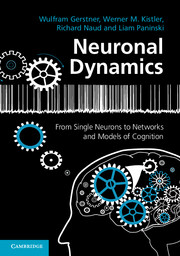Book contents
- Frontmatter
- Contents
- Preface
- PART ONE FOUNDATIONS OF NEURONAL DYNAMICS
- PART TWO GENERALIZED INTEGRATE-AND-FIRE NEURONS
- PART THREE NETWORKS OF NEURONS AND POPULATION ACTIVITY
- 12 Neuronal populations
- 13 Continuity equation and the Fokker–Planck approach
- 14 Quasi-renewal theory and the integral-equation approach
- 15 Fast transients and rate models
- PART FOUR DYNAMICS OF COGNITION
- References
- Index
13 - Continuity equation and the Fokker–Planck approach
Published online by Cambridge University Press: 05 August 2014
- Frontmatter
- Contents
- Preface
- PART ONE FOUNDATIONS OF NEURONAL DYNAMICS
- PART TWO GENERALIZED INTEGRATE-AND-FIRE NEURONS
- PART THREE NETWORKS OF NEURONS AND POPULATION ACTIVITY
- 12 Neuronal populations
- 13 Continuity equation and the Fokker–Planck approach
- 14 Quasi-renewal theory and the integral-equation approach
- 15 Fast transients and rate models
- PART FOUR DYNAMICS OF COGNITION
- References
- Index
Summary
In the previous chapter, the notion of a homogeneous population of neurons was introduced. Neurons within the population can be independent, fully connected, or randomly connected, but they should all have identical, or at least similar, parameters and all neurons should receive similar input. For such a homogeneous population of neurons, it is possible to predict the population activity in the stationary state of asynchronous firing (Section 12.4). While the arguments we made in the previous chapter are general and do not rely on any specific neuron model, they are unfortunately restricted to the stationary state.
In a realistic situation, neurons in the brain receive time-dependent input. Humans change their direction of gaze spontaneously two or three times per second. After each gaze change, a new image impinges on the retina and is transmitted to the visual cortex. Auditory stimuli such as music or traffic noise have a rich intrinsic temporal structure. If humans explore the texture of a surface which by itself is static, they move their fingers so as to actively create temporal structure in the touch perception. If we think back to our last holiday, we recall sequences of events rather than static memory items. When we type a message on a keyboard, we move our fingers in a rapid pattern.
- Type
- Chapter
- Information
- Neuronal DynamicsFrom Single Neurons to Networks and Models of Cognition, pp. 325 - 356Publisher: Cambridge University PressPrint publication year: 2014



